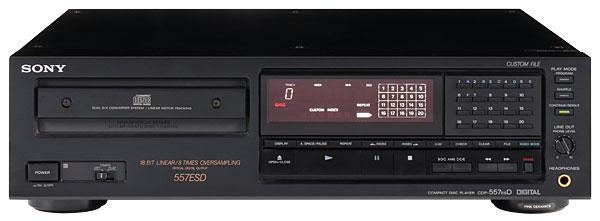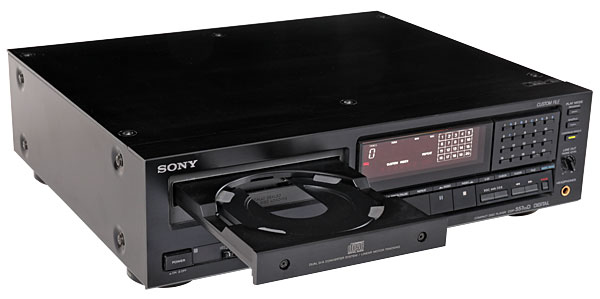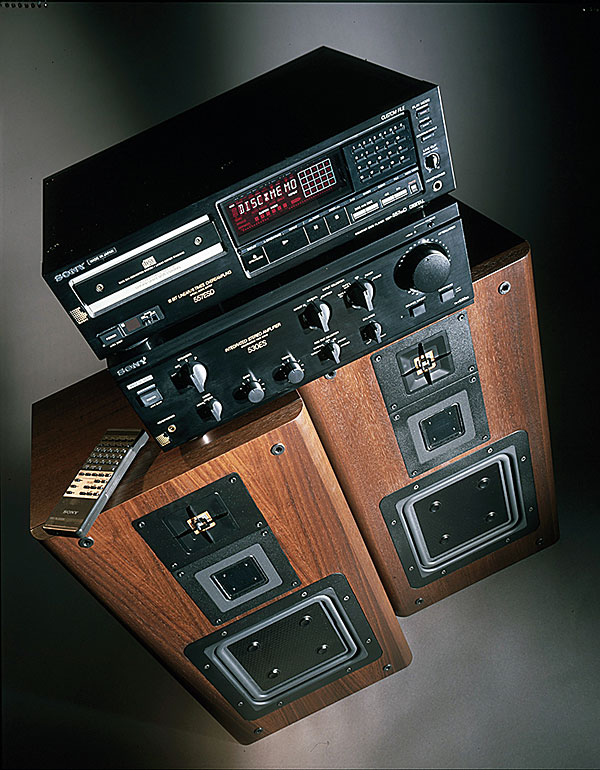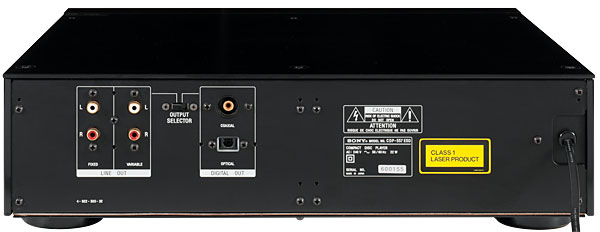Sony CDP-557ESD CD player

 This CD player from 1987 re-wrote the rules with its offer of 18-bit/8x oversampling while cutting few corners in the quality of its componentry. How will it sound today?
This CD player from 1987 re-wrote the rules with its offer of 18-bit/8x oversampling while cutting few corners in the quality of its componentry. How will it sound today?
Back in the '70s, Japanese consumer electronics giants sold hi-fi based on so-called 'tech specs'. What began as a trend became an obsession, each new turntable being offered with lower claimed wow, flutter and rumble as 'proof' that it was superior to the one before. Indeed, some brands took to running ads highlighting the measured performance of components, with straplines to the effect of 'let the facts speak for themselves'. Back in hi-fi's boom years, such was the way of the world...
Then, in the early '80s, along came Compact Disc. Given that CD players – at least when put together properly – had fairly similar measured performance, manufacturers had to find new ways to capture the buying public's imagination. And one of these was to highlight the bit depth and oversampling rate of a machine's built-in DAC.
For five years an 'arms race' ensued, where 16-bit/2x oversampling was bettered by 16-bit/4x and so on. And then, in 1987, Sony shocked the market with a new flagship machine said to offer 18-bit/8x oversampling. It was the CDP-557ESD (sold in the US as the CDP-707ESD).

This explains why the legend '18 bit linear/8 times oversampling' is to be seen emblazoned in capital letters on the player's sizeable front panel. It was believed that the average buyer would immediately assume this technology to be superior to that of his best friend's 16-bit/4x machine, and out would come the cheque book. Or so the theory went!
Nevertheless, this was indeed a formidable CD player, its techno trickery made possible by the use of twin 18-bit Burr-Brown PCM64P DACs paired up. This was an impressive selling point in itself, but it's actually just one of many striking aspects of the player.
In At The Top
Launched at the height of the CD boom, the CDP-557ESD cost a whopping £1000 in the UK, making it strictly off limits for the majority of British buyers. Yet it actually sold in appreciable numbers, partly to those seeking to replace an ageing first generation machine, while others splashed their cash to join the digital audio world at the very top. There was nowhere to run for this Sony player – it just had to be right.

This explains its aesthetics, ergonomics, build and finish. One of the player's main challenges was to wow customers in hi-fi showrooms across the world. In its native Japan, many buyers gazed at products stacked high in massive electrical retailers such as Yodobashi Camera and bought components on their look and feel. For this reason, this machine is an essay in how to impress well-heeled Japanese salarymen of the 1980s, ready to blow their Golden Week bonuses on a new CD player.
It's big, strong, chunky and covered in buttons, showing an uncompromising aesthetic. It was – lest we forget – designed just before the Japanese so-called 'bubble economy' began to slowly deflate in 1987. Rather like a supercar launched immediately before an oil crisis, it has a certain over-the-top, fin de siècle feel.
Never mind the quality, feel the weight! This 430x125x375mm (whd), 17kg behemoth is mostly metal, with many different surface finishes used for various parts of the fascia, switchgear, casing and internals. It is built on Sony's so-called 'Gibraltar' chassis, which has a thick bottom plate made of steel and another section of calcium carbonate, glassfibre and resin. Sony's BU-1 aluminium diecast transport assembly was fitted to this, containing the spindle drive motor, the linear motor for the laser pick-up and twin magnetic rails, plus the KSS-190A mechanism itself.
First Time Filter
Meanwhile, twin potted and shielded power transformers sit separately but adjacent to one another, feeding the digital and audio circuitry respectively, with felt pad damping, of course. Componentry is lavish, with expensive Elna audio capacitors used extensively. Those Burr-Brown PCM64P DACs are ceramic damped, and paired with a Sony CXD1144A 18-bit/8x digital filter – said to be the first ever 8x oversampling filter used in a consumer audio product.

The choice of Burr-Brown chips suggests that Sony didn't have a suitable alternative, because it was the second time it had bought in silicon from another manufacturer, having fitted a Philips TDA1541A to this player's CDP-555ESD predecessor. As for other niceties, these include a neoprene rubber seal around the disc drawer to prevent the ingress of vibrations into the mechanism, while the metal disc tray has a beautifully swish action – being silent and fast.
The player's cost-no-object battleship build makes it a pleasure to use, but that's not the half of it. The CDP-557ESD is also packed with features, from a 'music calendar' to Sony's 'Custom File' system. The latter was Sony's early attempt to offer CD text, albeit programmed by the user and not stored in the disc's own 'table of contents'. Yet what impresses the most about the machine was – and is – its lightning-fast track access. The direct-entry track 'keypad' takes great advantage of this: key in track 24 (assuming you have a disc with that many tracks), and in under a second it starts playing, even if the deck was in stop mode before. Nothing of its time came close.

Round the back, there's one interesting omission for a CD player that's supposed to have everything. Unbalanced RCA line outputs are fitted (in fixed and variable form) but no balanced XLR analogue outs. All Sony's following '7-series' models had them so one might have expected this machine to be thus equipped. Indeed, balanced XLR analogue outs duly went on to become de rigueur and a kind of badge of honour for Sony's top machines.
However, the CDP-557ESD offers a choice of Toslink and electrical coaxial digital outputs and was the only player in the year's range to provide both, lesser models having just an optical digital out. This marked out this machine's status as the flagship of the series.
![]() David Listens
David Listens
The 'surprise and delight' this player brings doesn't end with its speedy track access times, because its sound ensures it stands out from the crowd too – even if its presentation will be sure to divide opinion. Overall its sound is ultra fast and super detailed, meaning whichever recording you care to play it sounds as if it has had an ultra high intensity search-light shone on it. This makes for a fascinating listening experience – even in 2020 – so would have been a remarkable one back in 1987.























































